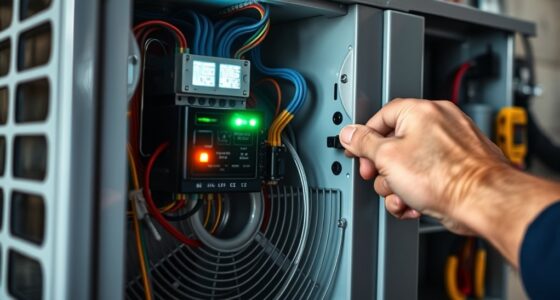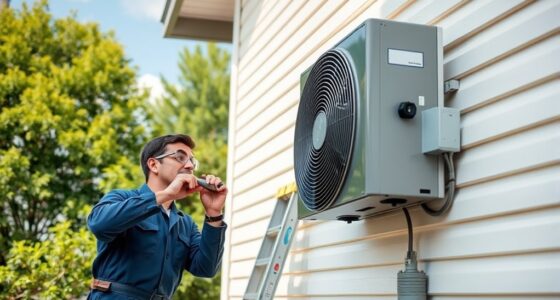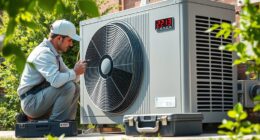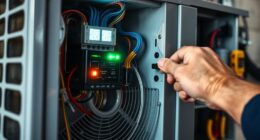Choosing between professional and DIY heat pump installation depends on your skills, budget, and safety priorities. Professionals guarantee proper setup, compliance with codes, and protect warranties, reducing risks and future repair costs. While DIY can save money upfront, improper installation can lead to safety hazards and system failure. If you want to learn more about the complexities, costs, and benefits involved, keep exploring these important considerations.
Key Takeaways
- Professional installation ensures compliance with local codes, safety standards, and manufacturer warranties, reducing legal and safety risks.
- Skilled technicians have the tools and expertise to handle complex refrigerant lines, electrical wiring, and calibration accurately.
- DIY installation may save upfront costs but risks voiding warranties and incurring expensive repairs from improper setup.
- Professionals optimize system performance and energy efficiency, extending the heat pump’s lifespan through proper installation and maintenance.
- Choosing experts guarantees adherence to industry standards, safeguarding long-term reliability, safety, and legal compliance.
Understanding the Differences Between Professional and DIY Installation
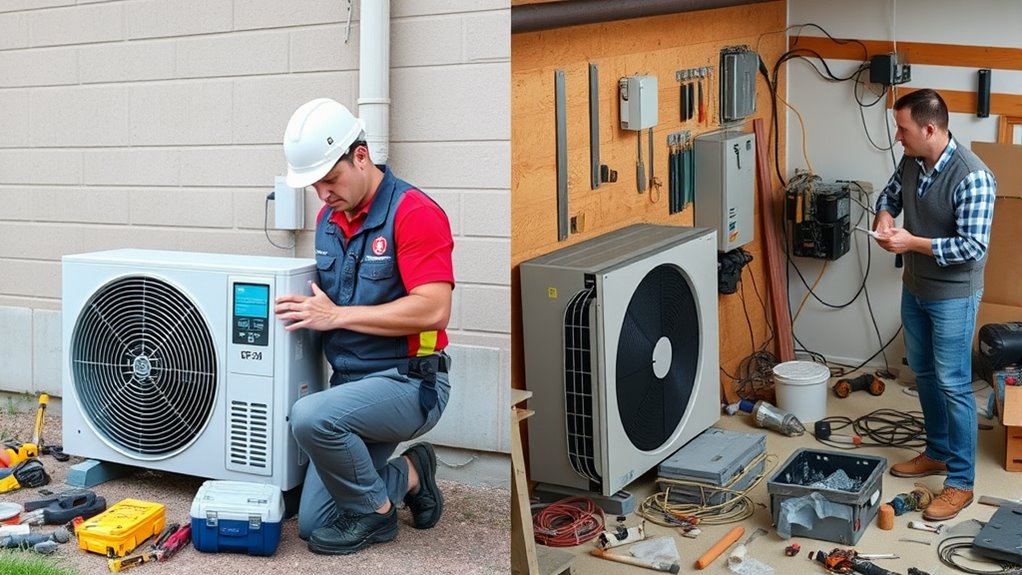
Understanding the differences between professional and DIY heat pump installation is essential before you decide which route to take. Professional installation ensures your system meets local codes and manufacturer standards, reducing the risk of malfunctions. A licensed technician has the expertise and tools needed for precise refrigerant line flare connections and electrical wiring, which are often tricky for DIY approach. When you hire a professional, they can properly size, place, and calibrate your system, maximizing system efficiency and performance. Additionally, professional installation usually comes with warranties on labor and equipment, protecting your investment. Many regions also require licensed professionals for HVAC setups to ensure safety and compliance. Choosing professional installation means peace of mind, better system performance, and adherence to all safety regulations. Proper installation also considers noise levels to ensure your heat pump operates quietly and comfortably within your home. Moreover, professional installers are trained to follow fire safety regulations, helping prevent hazards during and after installation. Engaging a professional also ensures that proper system calibration is performed, which is crucial for optimal operation. Furthermore, a professional approach minimizes the potential for costly repairs caused by improper setup or mistakes during installation. Properly installed systems can also optimize energy efficiency, leading to lower utility bills over time.
The Complexity and Technical Skills Required for Heat Pump Setup

Installing a heat pump involves complex tasks that require specialized tools and technical skills. You need to make precise refrigerant line connections, correctly position units, and handle electrical wiring safely. Without proper training, these steps can be risky and difficult to get right. For instance, performance upgrades in Nissan tuning demonstrate the importance of precise modifications to achieve optimal results, which is similar to the meticulous work needed in heat pump installation. Additionally, understanding refrigerant handling is crucial to ensure safety and efficiency during setup. Properly managing suspension and handling components ensures the system operates reliably and efficiently over time. Moreover, AI safety measures emphasize the importance of continuous monitoring and adherence to best practices to prevent potential issues during complex installations. Being aware of diversify investments can also help safeguard your financial resources if unexpected issues arise during technical projects.
Installation Technical Demands
Because heat pump installation involves handling delicate refrigerant lines and precise system placement, it demands a high level of technical skill. Proper installation requires using specialized flare tools to prevent leaks and guarantee reliable operation. You also need a solid understanding of HVAC principles to accurately size and position indoor and outdoor units, optimizing airflow and efficiency. For ductless mini-split systems, careful mounting and wiring in tight spaces call for advanced electrical skills. Ground-source systems involve excavation and underground piping, requiring complex soil assessments and specialized equipment. Additionally, adhering to local codes and manufacturer guidelines is vital, often needing certified techniques and thorough documentation. These technical demands highlight why professional HVAC installation is typically recommended for ensuring safety, performance, and compliance. Proper training in airless paint sprayer operation can also minimize errors and improve overall results, especially considering the importance of system calibration in achieving optimal efficiency. Moreover, a comprehensive understanding of system design principles can significantly influence long-term performance and energy savings. Mastery of refrigerant handling is essential to prevent environmental hazards and ensure system longevity.
Necessary Specialized Tools
Setting up a heat pump requires specialized tools that go beyond basic household equipment, making technical skill vital. Without these tools, you risk improper installation and costly issues. Here are four key items you’ll need:
- Refrigerant flare tool – for making secure refrigerant line connections and preventing leaks.
- Vacuum pump – to remove air and moisture from the system before charging.
- Manifold gauge set – to measure pressures during refrigerant charging and system diagnostics.
- Electrical testers and multimeters – to ensure safe, code-compliant electrical wiring and control system connections.
Handling refrigerants safely and making precise connections demand expertise. Using the right specialized tools is vital for a reliable, efficient heat pump installation—something best left to professionals or highly trained DIYers. Proper calibration and understanding of dynamic communication exercises for couples can also improve your troubleshooting skills during installation.
Cost Analysis: DIY vs. Professional Installation Expenses

When comparing costs, DIY heat pump installation can substantially reduce upfront expenses by eliminating labor fees, potentially saving you between $1,500 and $4,000. Professional installation costs typically range from $3,000 to $8,000, with labor expenses accounting for a significant portion due to hourly rates of $75 to $125. These labor costs can heavily influence the total installation expenses, especially if additional permits, inspections, or modifications are needed. While DIY can lower initial costs, keep in mind that improper installation may lead to costly repairs or voided warranties, which could negate the savings. Carefully weigh the potential for immediate cost savings against the risks and possible future expenses associated with an incorrect installation. Additionally, understanding the importance of proper installation techniques can help ensure you avoid common pitfalls. Being aware of certification requirements can also assist in making sure your installation meets safety and efficiency standards. Proper training and knowledge are essential for a successful DIY project and can help prevent mistakes that might compromise system performance. Moreover, consulting professional guidelines can provide valuable insights to improve your installation quality. Recognizing local building codes is also crucial to ensure compliance and avoid legal issues during installation.
Safety, Compliance, and Warranty Considerations

Choosing professional installation guarantees your heat pump meets all safety standards and complies with local building codes. This reduces risks and ensures your system operates reliably. A licensed professional handles refrigerants, electrical connections, and system components safely, lowering hazards. Additionally, proper installation by a certified technician preserves your manufacturer’s warranty. Without professional work, warranties can be voided, leading to costly repairs. To emphasize, consider these points:
- Certified professionals follow strict safety and compliance standards.
- Proper installation minimizes refrigerant leaks and electrical faults.
- Warranties often require proof of professional installation for coverage.
- DIY work can jeopardize safety, system reliability, and warranty protection.
- Ensuring your installation meets industry standards safeguards your investment and guarantees optimal system performance. Proper installation also ensures compliance with building codes, preventing potential legal issues. It is also important to recognize that proper installation techniques are essential for maintaining system efficiency and longevity. Moreover, professional expertise can identify and address potential issues early, avoiding costly repairs down the line. Additionally, understanding system specifications is crucial for optimal operation and energy efficiency.
When to Opt for a Professional Installer
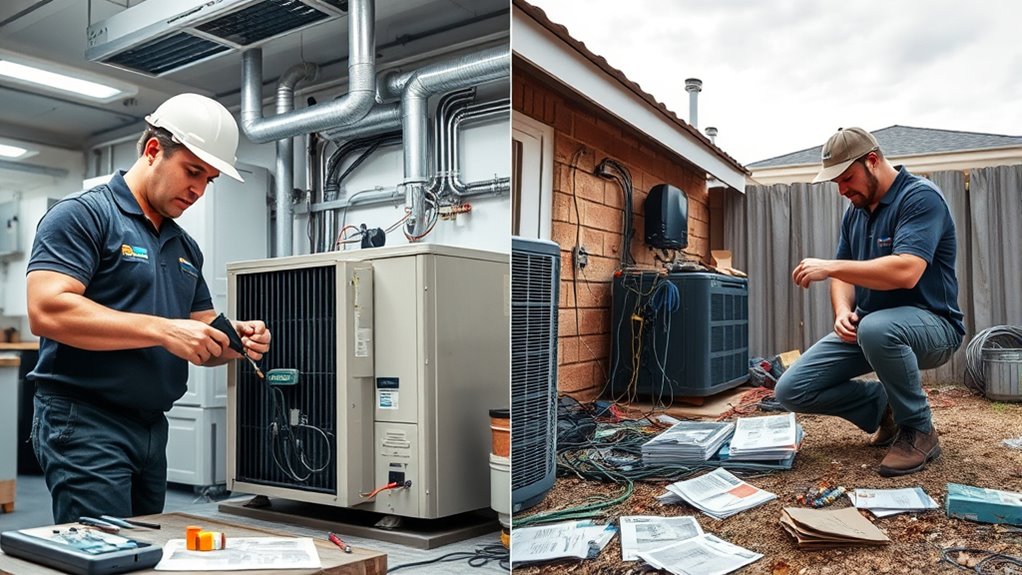
First-time heat pump installations should typically be handled by professionals to guarantee everything is set up correctly and meets local codes. A professional installation ensures proper electrical wiring, which is critical for safety and system efficiency. If you’re unfamiliar with HVAC systems or unsure about local building codes, hiring a licensed technician is your best choice. Complex setups or unfamiliar configurations can lead to improper installation, risking damage, reduced performance, or voided warranties. Even if you’re experienced with DIY projects, electrical wiring and refrigerant handling require specialized skills and safety precautions. When in doubt about your technical ability or compliance with regulations, consulting a pro makes certain your heat pump operates safely, efficiently, and in accordance with local codes. Additionally, understanding solar panel efficiency can help in assessing the overall energy performance of your system. Incorporating knowledge of mindfulness techniques can also promote a more relaxed and focused approach during installation, reducing errors and enhancing safety. Recognizing technician certifications can further ensure that your installer has the necessary expertise and adheres to industry standards.
Long-Term Performance and Maintenance Implications
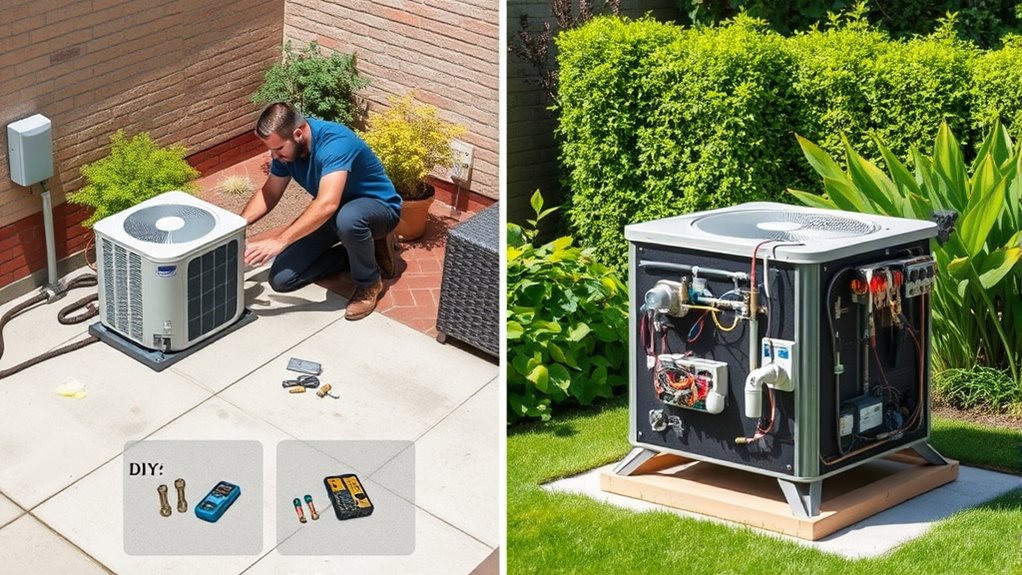
Proper professional installation plays a crucial role in ensuring your heat pump performs efficiently over its lifespan. A correctly installed system helps maintain ideal performance and reduces ongoing energy costs. Regular maintenance by certified technicians is essential to catch issues early, preventing costly repairs and system failure. When installed properly, your unit is more likely to retain its manufacturer warranty, providing long-term support. Conversely, poorly installed units often face operational problems within the first few years, leading to higher repair costs and a shorter lifespan. Prioritizing professional installation and scheduled maintenance can extend your heat pump’s service life to 15-20 years, compared to just 10-15 years for improperly installed or neglected systems.
Key considerations:
- Enhanced performance and efficiency
- Reduced maintenance costs
- Longer system lifespan
- Preservation of warranty coverage
Frequently Asked Questions
Can I Buy a Heat Pump and Install It Myself?
You can buy a heat pump and try installing it yourself, but it’s not recommended. Installing a heat pump requires specialized tools, knowledge of electrical systems, refrigerant handling, and precise calibration. If you lack experience, you risk leaks, inefficiency, or damage, which could cost more to fix. Plus, many regions require professional installation for warranties, rebates, and safety compliance. It’s best to hire a licensed expert for proper, safe installation.
Are You Allowed to Install Your Own Heat Pump?
Back in the day, folks could tinker more freely with home projects, but now, you’re generally not permitted to install your own heat pump. Local codes and regulations require licensed professionals to guarantee safety and proper functioning. Doing it yourself risks fines, voided warranties, and environmental hazards due to improper refrigerant handling. To stay compliant and protect your investment, it’s best to hire a certified HVAC contractor for installation.
Why Don’t Contractors Like Heat Pumps?
You might wonder why contractors avoid heat pumps, and it’s mainly because they’re complex to install. Handling refrigerants, electrical wiring, and precise connections require specialized skills and training. Mistakes can cause malfunctions, warranty issues, and customer dissatisfaction. Plus, stricter regulations and licensing make the process more challenging. The lower profit margins and ongoing technical updates also discourage many contractors from offering heat pump installation, preferring simpler, more familiar systems.
What Qualifications Do I Need to Install Heat Pumps?
To install a heat pump, you’ll need specific qualifications. You should be a licensed HVAC technician with EPA certification to handle refrigerants safely. Knowledge of electrical wiring, refrigerant lines, and proper system sizing is essential, and many certifications like NATE verify these skills. Keep in mind, DIY installation isn’t recommended, as it often doesn’t meet code requirements and could lead to safety hazards or voided warranties.
What Is the Average Cost of a Heat Pump Installation?
You’re wondering about the cost of a heat pump installation, but the price can surprise you. On average, it ranges from $3,500 to $7,500, depending on system type and complexity. Ductless mini-splits are more affordable, around $2,000 to $5,000, while ducted systems can climb over $10,000. Remember, professional installation guarantees efficiency and warranty protection, often making the higher cost worthwhile.
Conclusion
Choosing between DIY and professional heat pump installation isn’t just about saving money—it’s about knowing what’s truly at stake. While DIY might seem tempting, the risks of improper setup could lead to costly repairs or safety hazards down the line. But what if the right choice could *release* long-term performance and peace of mind? The decision isn’t simple, and the real question is—are you prepared to face the unexpected that could change everything?


